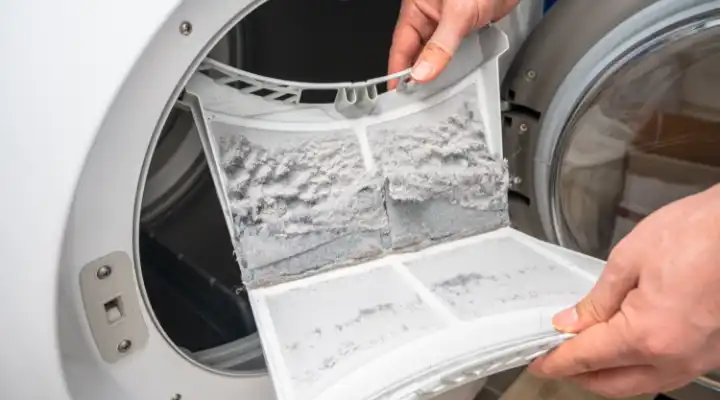Although many users overlook it, the washing machine filter is one of the key components for proper operation. Its function is to retain debris such as lint, coins, buttons, hair, and other small objects that can end up in the pipes during the wash cycle. If this filter becomes clogged, a number of problems can occur: from unpleasant odors to problems draining water or completing cycles correctly.
In this article, we explain why it’s important to clean your washing machine’s filter, how often you should do it, and how to do it safely and effectively, step by step. If you live in Panama and want to extend the life of your appliance, this guide will be very useful.
Why is it important to clean the filter?
The filter acts as an internal protective barrier. When it becomes clogged, water doesn’t circulate properly inside the drum or to the drain pump. This can cause several problems, including:
- The washing machine doesn’t drain water or drains it very slowly.
- The clothes come out smelly, even after washing.
- An error appears on the panel or the cycle is interrupted.
- Electricity consumption increases due to overexertion of the motor.
- The drain pump can burn out if it works with too much pressure.
Cleaning the filter regularly—ideally every one or two months—helps prevent these failures, improves the equipment’s performance, and avoids costly repairs.
Where is the washing machine filter?
The filter’s location may vary slightly depending on the brand or model, but it’s usually located on the bottom front of the washing machine, behind a small cover or access panel.
On front-loading washing machines, it’s usually visible or covered by a plastic cover that you can easily open. On some top-loading models, the filter may be inside the drum, in the form of a removable basket or rack.
If you’re unsure, consult your owner’s manual or search for the specific model online. You can also contact a technician if you prefer professional advice.
What do you need to clean the filter?
Before you begin, have the following items ready:
- A low container or tray to collect any residual water.
- An old cloth or towel to dry the area.
- An old toothbrush or small brush to clean debris.
- Rubber gloves (optional, but recommended).
It’s also important to unplug the washing machine before handling any parts, for safety reasons.
How to Clean the Washing Machine Filter: Step by Step
- Disconnect and locate the filter
Turn off the washing machine and unplug it. Then, locate the cover that protects the filter (usually on the lower right or left side of the front of the machine).
- Prepare the area
Place a tray or container under the filter to collect accumulated water. Some washing machines have an auxiliary drain hose for controlled drainage. If yours doesn’t, simply carefully unscrew the filter and let the water drain slowly.
- Remove and clean the filter
Once the water has drained, remove the filter. You’ll notice that it may have buildup of lint, detergent residue, thread, coins, or other objects. Clean it with the brush under the tap until it’s completely free of residue.
- Clean the internal cavity
Using a cloth or a longer brush, also clean the area where the filter is installed. Sometimes, dirt can remain in this area, which also affects its performance.
- Reinstall the filter
Put the filter back in place, make sure it’s tight, and close the protective cover.
- Reconnect and test
Reconnect the washing machine, select a short cycle without clothes, and run some water to check that everything is working properly and that there are no leaks.
How often should you clean the filter?
The ideal frequency depends on how you use your washing machine. If you wash daily or several times a week, it’s recommended to clean the filter once a month. However, if you use your washing machine only once or twice a week, you can do it every two months.
You should also check the filter immediately if you notice any of these symptoms:
- The washing machine won’t drain.
- An error appears on the digital panel.
- You smell unpleasant odors coming from the drum.
- There is stagnant water or small leaks.
Timely cleaning can prevent the problem from escalating and becoming a major breakdown.
What happens if you never clean it?
Ignoring filter maintenance can lead to serious problems. If the drain motor is forced to work due to a prolonged blockage, it could burn out. Furthermore, the accumulation of organic waste can generate bacteria and unpleasant odors that affect both clothes and the home environment.
In the worst-case scenario, a washing machine with a clogged drainage system could suffer internal leaks, damage the pump, or even damage the electronic board due to moisture.
Therefore, although cleaning the filter may seem like a minor task, it is one of the most important maintenance actions you can do yourself to keep your appliance in good condition.
Keep in mind that…
Keeping your washing machine filter clean is a simple, quick task that can save you a lot of headaches. It only takes a few minutes a month to prevent breakdowns, improve washing performance, and ensure more efficient operation of your machine.
If you have questions about how to do this on your specific model, or if you notice more complex problems such as noises, errors on the screen, or leaks, don’t hesitate to contact a technical workshop specializing in washing machine repair in Panama. A timely professional check-up can prevent further damage and extend the life of your appliance.

